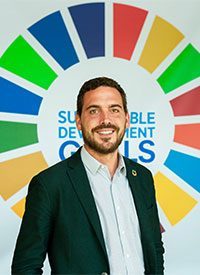The importance of net-zero has never been more evident – and given the extent to which CO2 emissions arise from the built environment, it’s no surprise that this is a particular area of focus. But as industry experts explained at BNP Paribas’ recent Sustainable Future Forum, achieving net-zero is also a goal that will require a significant change of mindset.
The built environment represents 40% of CO2 emissions globally, and more than half of the world’s population now lives in an urban environment – a figure that is set to rise to almost 70% by 2050.
“Embodied carbon in building materials and equipment needs to be reduced by at least 40% from today’s level by 2030. Alignment and collaboration between all the players of the built environment value chain is crucial as no-one can do it alone,” noted Alexandre Belin, CIB Company Engagement – Projects & Partnerships, BNP Paribas, in his opening remarks to set the scene for the discussion.
While it is clear that action is needed, one major challenge is a lack of clarity about what the future will look like. “We are preparing for the future in a situation where we need to double the infrastructure investment in the coming years to fill the infrastructure gap,” Jose Luis Blasco Vazquez, Global Sustainability Director, Acciona,pointed out. “At this stage, 75% of the infrastructure we will enjoy in 2050 is still underway – we have no idea how this infrastructure will work.”

We need to change the way that we are now doing things. And to do that, we need new materials, we need new designs – but we also need to have a new mindset, in order to provoke to our supply chains to evolve in this direction.
Jose Luis Blasco Vazquez, Global Sustainability Director, Acciona
Material challenges
To solve the crisis going forward, “we need both energy efficiency, and a fundamental system reboot in terms of basing everything on renewable energy, new technologies and storage, grid optimisation and grid resilience. These are the things in the built environment that are going to make our cities capable of meeting those goals,” said Alexis Haass, Chief Sustainability Officer at Arcadis.
In particular, she emphasised the importance of circular materials which, on average, tend to improve the embodied carbon in the built environment. She pointed out that this is both a safety and a comfort issue: cities are functionally “heat islands”, so they will experience global warming more intensely than other parts of the globe. As such, the IEA’s 2018 Future of Cooling report predicted that the energy needed to cool cities will triple by 2050. Haass argued that addressing this issue will require not just smart technologies, but also social and biodiversity solutions.

There is a huge role in finance for the bond market and for insurance in this space.
Alexis Haass, Chief Sustainability Officer at Arcadis
A world without concrete?
Cement and concrete represent 8-10% of the world’s CO2 emissions. “We know that concrete is the second most used resource after water. More and more new green concrete products have been designed to make our cities more sustainable but also more resilient,” said Belin.
For Magali Anderson, Chief Sustainability and Innovation Officer and Group ExCo Member at Holcim, one of the world leaders in cement and ready-mix concrete, this is an important focus for the industry, with the Global Cement and Concrete Association recently announcing that the industry is committed to reaching net zero by 2050.
But Anderson also emphasised the importance of looking at how much CO2 is used over the entire life of a building, including heating, transportation and fire resistance. “You will conclude very quickly when you do a lifecycle assessment that concrete is actually the most sustainable material,” she commented, pointing out that construction demolition waste can be added to aggregate, concrete and cement.
Turning to the future, Blasco Vazquez outlined Acciona’s vision that infrastructure and technology will be “invisible”, adding that materials themselves will evolve. “We need to change the way that we are now doing things,” he said. “And to do that, we need new materials, we need new designs – but we also need to have a new mindset, in order to provoke to our supply chains to evolve in this direction.”
Citing the creation of a vertical forest in Milan, Anderson pointed out that the number of people that will be moving into cities in the next 30 years was the equivalent of building New York City every month – “and we cannot do it without reconciling nature and the city.”

[Sustainable finance] is a very strong support to what we’re doing. It really shows full alignment in the company, and helps our leaders to act and accelerate on sustainability.
Magali Anderson, Chief Sustainability and Innovation Officer and Group ExCo Member, Holcim
The role of sustainable finance in the built environment
Blasco Vazquez described the European Commission’s European Sustainable Finance Action Plan as a “game changer”. “Our recommendation is first of all, to identify if your company is aligned with this new strategy,” he said. “Have a look at the EU taxonomy, because it’s a dictionary of green activities. If your company is aligned with these activities, you have the opportunity to invest better in this net-zero future.”
Turning to the role of sustainable finance in supporting innovation, Anderson said that sustainable finance “is a very strong support to what we’re doing,” citing Holcim’s 2020 issuance of an €850 billion sustainability-linked bond that was 2.7 times oversubscribed. “The idea is to say that if we don’t reach our 2030 CO2 target, it’s going to cost us a few million,” she commented. “It really shows full alignment in the company, and helps our leaders to act and accelerate on sustainability.”
Arcadis, meanwhile, has recently released a sustainability-linked revolving credit facility, as well as triggering new practices in sustainable finance – developments that Haass said have been well-received by the market, as well as aligning the company’s finance and business goals. She commented that with companies now required to report on their climate risk exposures, “The next question coming from investors is, ‘How do you plan to solve that?’”
As Haass concluded: “There is a huge role in finance for the bond market and for insurance in this space. Frankly, several of the large projects – especially large infrastructure projects – should no longer be appealing, because they are too carbon intensive. Nor should they be insurable – and this is actually what we’re starting to see.”
To achieve Net Zero in 2050, the built environment needs tohalve its emissions by 2030. In order to achieve this goal, the entire industry must worktogetheralong its value chain & lifecycle, it will need to set upa common language for carbon emissions for all the players involved in manufacturing, designing, constructing, investing, owning, operating, occupying, renovating and demolishing building to identify the best emissions-reduction strategies along the value chain.

Alignment and collaboration between all the players of the built environment value chain is crucial as no-one can do it alone
Alexandre Belin, CIB Company Engagement, Projects & Partnerships, BNP Paribas